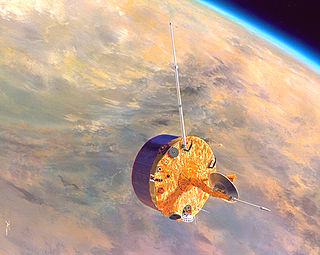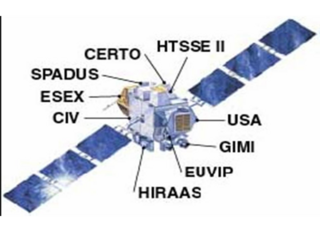Related Research Articles

The ionosphere is the ionized part of the upper atmosphere of Earth, from about 48 km (30 mi) to 965 km (600 mi) above sea level, a region that includes the thermosphere and parts of the mesosphere and exosphere. The ionosphere is ionized by solar radiation. It plays an important role in atmospheric electricity and forms the inner edge of the magnetosphere. It has practical importance because, among other functions, it influences radio propagation to distant places on Earth.

The Pioneer Venus Orbiter, also known as Pioneer Venus 1 or Pioneer 12, was a mission to Venus conducted by the United States as part of the Pioneer Venus project. Launched in May 1978 atop an Atlas-Centaur rocket, the spacecraft was inserted into an elliptical orbit around Venus on December 4, 1978. It returned data on Venus until October 1992.

The High-frequency Active Auroral Research Program (HAARP) was initiated as an ionospheric research program jointly funded by the U.S. Air Force, the U.S. Navy, the University of Alaska Fairbanks, and the Defense Advanced Research Projects Agency (DARPA). It was designed and built by BAE Advanced Technologies. Its original purpose was to analyze the ionosphere and investigate the potential for developing ionospheric enhancement technology for radio communications and surveillance. Since 2015 it has been operated by the University of Alaska Fairbanks.

A geomagnetic storm, also known as a magnetic storm, is a temporary disturbance of the Earth's magnetosphere caused by a solar wind shock wave and/or cloud of magnetic field that interacts with the Earth's magnetic field.

FalconSAT is the United States Air Force Academy's (USAFA) small satellite engineering program. Satellites are designed, built, tested, and operated by Academy cadets. The project is administered by the USAFA Space Systems Research Center under the direction of the Department of Astronautics. Most of the cadets who work on the project are pursuing a bachelor of science degree in astronautical engineering, although students from other disciplines join the project.
The Space Test Program (STP) is the primary provider of spaceflight for the United States Department of Defense (DoD) space science and technology community. STP is managed by a group within the Advanced Systems and Development Directorate, a directorate of the Space and Missile Systems Center of the United States Space Force. But STP is a DoD-wide organization. STP provides spaceflight via the International Space Station (ISS), piggybacks, secondary payloads and dedicated launch services.

CFESat, the Cibola Flight Experiment Satellite, examines radio spectra for ionospheric and lightning studies, using field-programmable gate arrays (FPGAs). As well as science observation, the mission aims to show use of reconfigurable FPGAs to work in the radiation environment of low Earth orbit.
The Multi-Application Survivable Tether (MAST) experiment was an in-space investigation designed to use CubeSat spacecraft connected by tethers to better understand the survivability of tethers in space. It was launched as a secondary payload on a Dnepr rocket on 17 April 2007 into a 98°, 647 x 782 km orbit. The MAST payload incorporated three picosatellites, named "Ralph," "Ted," and "Gadget," which were intended to separate and deploy a 1 km (0.62 mi) tether. The experiment hardware was designed under a NASA Small Business Technology Transfer (STTR) collaboration between Tethers Unlimited, Inc. (TUI) and Stanford University, with TUI developing the tether, tether deployer, tether inspection subsystem, satellite avionics, and software, and Stanford students developing the satellite structures and assisting with the avionics design.

The Advanced Research and Global Observation Satellite (ARGOS) was launched on 23 February 1999 carrying nine payloads for research and development missions by nine separate researchers. The mission terminated on 31 July 2003.

C/NOFS, or Communications/Navigation Outage Forecasting System was an USAF satellite developed by the Air Force Research Laboratory (AFRL) Space Vehicles Directorate to investigate and forecast scintillations in the Earth's ionosphere. It was launched by an Orbital Sciences Corporation Pegasus-XL launch vehicle at 17:02:48 UTC on 16 April 2008 and decayed on 28 November 2015.

PicoSAT, launched on September 30, 2001, is a real time tracking satellite. The name "PICO" combines the first letters of all four of its experiments. PICOSat series are designed for a minimum of one year of on-orbit operations.
The Ionospheric Occultation Experiment (IOX) was a remote sensing satellite package that used a dual frequency Global Positioning System (GPS) receiver to measure properties of the ionosphere. IOX demonstrated remote sensing techniques for future United States Department of Defense space systems and helped to improve operational models for ionospheric and thermospheric forecasts.
The Polymer Battery Experiment (PBEX) demonstrates the charging and discharging characteristics of polymer batteries in the space environment. PBEX validates use of lightweight, flexible battery technology to decrease cost and weight for future military and commercial space systems. PBEX was developed by Johns Hopkins University and is one of four On Orbit Mission Control (OOMC) packages on PicoSat 9:
The On-Orbit Mission Control will be conducted by the Surrey Satellite Technology Ltd ground site in Guildford, UK. The United States Air Force Academy at Colorado Springs, Colorado will operate a backup ground station for PicoSAT satellite to increase the amount of experimental data.
Satya Prakash is an Indian plasma physicist and a former senior professor at the Physical Research Laboratory. He is known for his studies on Langmuir probes and other contributions in space and plasma sciences. A protégé of Vikram Sarabhai, Satya Prakash is an elected fellow of all the three major Indian science academies such as Indian Academy of Sciences, Indian National Science Academy and National Academy of Sciences, India as well as the Gujarat Science Academy and is a recipient of the Hari Om Ashram Prerit Senior Scientist Award. The Government of India honored him with Padma Shri, the fourth highest Indian civilian award for his contributions to the discipline of Physics, in 1982.
USA-221, also known as FalconSat-5, is an American military minisatellite, which was launched in 2010. The fifth FalconSat spacecraft to be launched, it carries four technology development and ionospheric research experiments. The satellite was constructed and is operated by the United States Air Force Academy.

RAX-2 is a CubeSat satellite built as a collaboration between SRI International and students at the University of Michigan College of Engineering. It is the second spacecraft in the RAX mission. The RAX-1 mission ended after approximately two months of operation due to a gradual degradation of the solar panels that ultimately resulted in a loss of power. RAX team members applied the lessons learned from RAX-1 to the design of a second flight unit, RAX-2, which performs the same mission concept of RAX-1 with improved bus performance and additional operational modes. Science measurements are enhanced through interactive experiments with high power ionospheric heaters where FAI will be generated on demand.

The Equatorial Vortex Experiment (EVEX) is a NASA-funded sounding rocket mission to better understand and predict the electrical storms in Earth's upper atmosphere. As part of this experiment, two rockets were launched for a twelve-minute journey through the equatorial ionosphere above the South Pacific. These rockets were launched from Kwajalein Atoll in the Marshall Islands during a period of April 27 to May 10, 2013.
The Illinois Observing Nanosatellite (ION) is the first CubeSat mission developed by the students of University of Illinois at Urbana-Champaign. The satellite was lost in the failure of the Dnepr launch on 26 July 2006. Completed in April 2005 as a part of the Illinois Tiny Satellite Initiative, the satellite took almost four years to be designed, built and tested by an interdisciplinary team of student engineers. The payloads included a photometer, a micro-thruster and a camera.

Explorer 22 was a small NASA ionospheric research satellite launched 9 October 1964, part of NASA's Explorer Program. It was instrumented with an electrostatic probe, four radio beacons for ionospheric research, a passive laser tracking reflector, and two radio beacons for Doppler navigation experiments. Its objective was to provide enhanced geodetic measurements of the Earth as well as data on the total electron content in the Earth's atmosphere and in the satellite's immediate vicinity.
References
![]() This article incorporates public domain material from websites or documents ofthe National Aeronautics and Space Administration .
This article incorporates public domain material from websites or documents ofthe National Aeronautics and Space Administration .